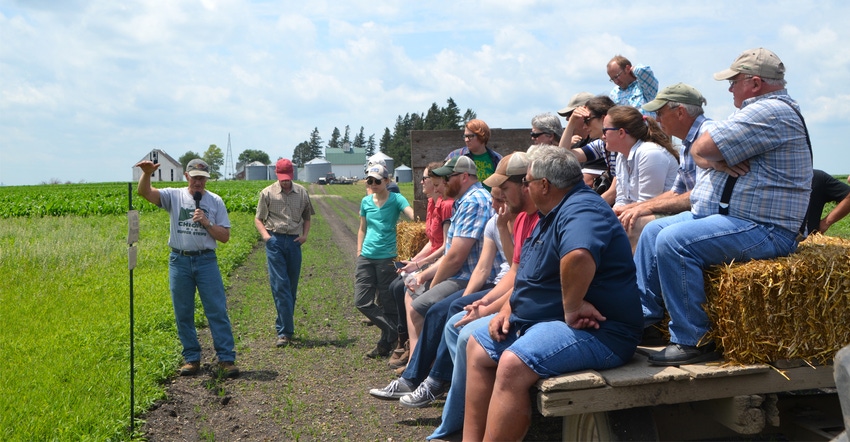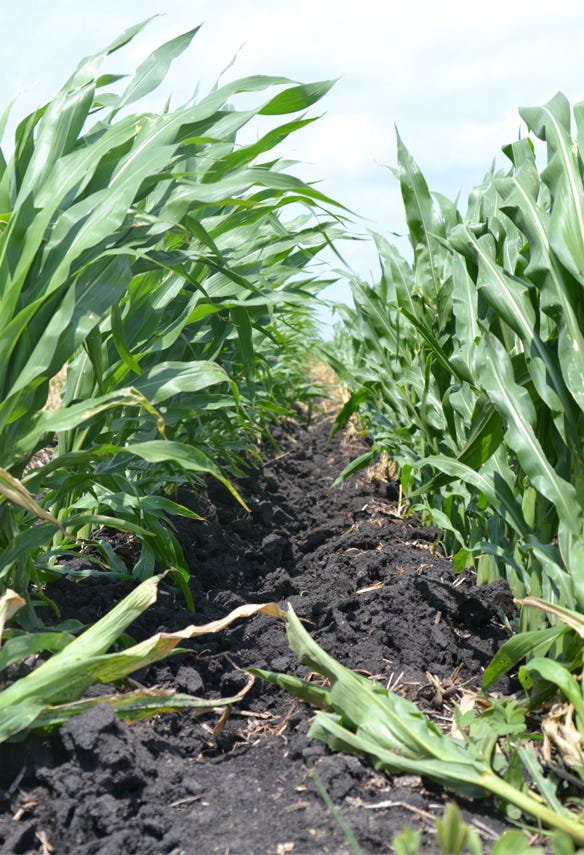September 1, 2017

“You’ve heard the song ‘Stuck in the Middle with You,’ that’s basically what I am,” says Craig Fleishman of Minburn. The central Iowa farmer hosted a field day with Practical Farmers of Iowa on June 28 on his farm, Cardinal Farm.
“I’m halfway between organic and industrial ag,” he says, “What I’m trying to do here is reach a balance between steel and herbicide. I’m trying to borrow a little bit from both sides. With this climate and these soils, I find it’s the best for what I’m trying to do. There’s enough tillage in the system to battle against resistant weeds and reduce the herbicide usage. But there’s enough herbicide, so when we have rainy periods in June, we still have weed control. It bridges that gap.”
Fleishman uses a ridge-tillage system, and has since 1981 after he read Ernie Behn’s book “More Profit With Less Tillage” and visited with Behn. For more information on ridge till, check the “Ridge-Till Roundtable” session from the 2017 PFI conference at youtube.com/pfivideos.
Ridge-till advantages evident
“The whole idea with ridge till is that you’re always planting into a consistent seedbed,” he explains, “and it’s a raised seedbed, so it drains off, and then your water is forced to the valleys where all the residue is, which reduces erosion potential.”
Since the field day in June, Fleishman has also seen that his ridge-tilled crops respond better to drought conditions because the deeply cultivated soil creates a sort of insulating blanket. “The ground doesn’t crack,” he says, “that little layer of soil stays loose and mellow.”
He cultivates corn twice: The first time he sidedresses with anhydrous; the second time is a more aggressive cultivation to build the ridges. He has also started to include a winter cereal rye cover crop on many of his corn and soybean acres, and he burns down the rye with herbicide about 10 days before planting (with beans, he did that the day before planting).
He says he hopes the rye will help with erosion control. The soil is exposed somewhat with ridge tillage, and he hopes that cover crop residue will help eliminate that bit of exposure.
Next year, beans will be planted on those ridges. For both corn and soybeans, he sprays a preemergence herbicide with the planter in a 15-inch band. That takes care of the weeds in the row, but he still has to deal with the middles of the rows, and that’s where the cultivator comes in.
On-farm testing
Fleishman has also long been experimenting with strip intercropping: planting strips of corn, soybeans and oats next to each other. Asked why he does it, he responded: “To give people something to talk about. And the field does look quite different than the surrounding landscape.”
He says growing crops in strips changes the plant architecture a little, and the outside rows produce more grain. The strip intercropping also breaks up the field pattern, and thus cuts down on gullies and erosion. “I don’t do the strip intercropping because it’s easy, that’s for sure,” he says.
Fleishman also takes water samples for on-farm research he’s conducting with the Iowa Soybean Association. He samples four tile locations on his farm and has been doing this for close to 10 years. “It’s interesting to know what’s in the water coming from my fields,” he says. In general, the water quality coming off of his farm is improving, but he says we all have a long way to go if we want to reach our goal.
 RIDGE TILL: Craig Fleishman’s mix of ridge-till cultivation and herbicide use allows him to save money and control erosion while combatting weed resistance.
RIDGE TILL: Craig Fleishman’s mix of ridge-till cultivation and herbicide use allows him to save money and control erosion while combatting weed resistance.

Strategies to protect and improve water quality need to be put in place on the ground, he notes. “And the easiest thing to do to reduce nutrient loss and improve water quality would be to move fall application of nitrogen to the spring, although research is now showing that one single step actually doesn’t make a great impact,” he adds. To significantly reduce the amount of nitrates in the water, “more of the land is going to have to be in cover crops and more edge-of-field practices, such as bioreactors and saturated buffers, will need to be installed.”
More edge-of-field practices needed
Creating more wetlands, wet prairies, buffer strips and other practices could be added to that list. He showed the crowd a wet area of his farm. That area is enrolled in a Conservation Reserve Program pollinator habitat program.
In addition to the beneficial insect habitat, and soil and water quality benefits of the native plants, one of the benefits of not farming those wet areas is that it’s easier on the tractor. “I haven’t been stuck with the tractor in 20 years,” he says, with his fingers crossed.
In addition to strip intercropping and installation of edge-of-field conservation practices that contribute to landscape diversity, Fleishman has added oats to his crop rotation, putting diversity into his cropping system. He’s working to improve yields and test weight of the grain, but he acknowledges there’s a learning curve to growing a crop that hasn’t been growing on large acreages in a generation.
“I don’t think we have everything figured out on the oats yet,” he says. “I’ve lost all of the lessons that my dad would have known.”
The slipping away of production knowledge is a common thread among farmers across Iowa. PFI has been working to bridge that gap over the last couple years. You can find more information about small-grain production on PFI’s website at practicalfarmers.org/small-grains.
Ohde writes for Practical Farmers of Iowa.
About the Author(s)
You May Also Like






